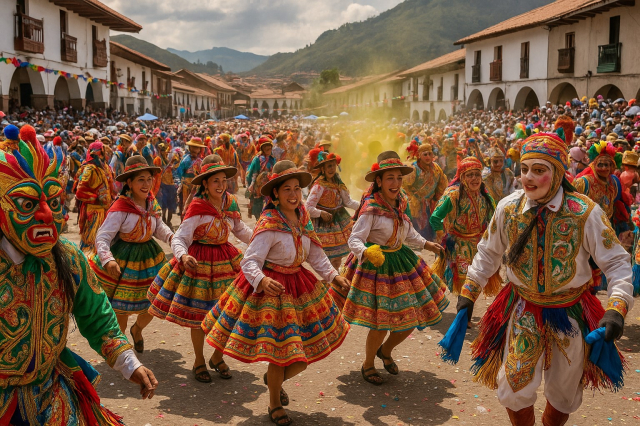Peru is a country that celebrates life through its festivals. Each region, from north to south, has its own way of experiencing Carnival, a celebration that combines music, dance, water, paint, and above all, community. Carnivals in Peru are celebrated mainly between February and March , coinciding with the agricultural calendar and the end of the rainy season.
More than just a celebration, carnivals reflect the country's cultural mix: a blend of Andean, Hispanic, and Amazonian traditions that fill the streets with color, troupes, and joy.
When are carnivals celebrated in Peru?
In most regions of Peru, carnivals are celebrated between the second week of February and the first week of March . However, the exact dates vary according to local customs.
Here is a summary of the main celebrations:
| Region | Approximate date | Featured celebration |
|---|---|---|
| Cajamarca | From February 10th to 14th | Cajamarca Carnival |
| Ayacucho | From February 15th to 20th | Ayacucho Carnival |
| Fist | From February 1st to 15th | Juliaca Carnival and festivities prior to Candelaria |
| Cusco | First week of March | Cusco Carnivals |
| Amazon | Second week of February | Amazonian Carnival of Chachapoyas |
| Lime | Last weekend of February | Lima carnivals and neighborhood events |
The Carnival of Cajamarca, the capital of Peruvian carnival
Cajamarca is officially recognized as the Carnival Capital of Peru . Its festival is one of the largest and most anticipated in the country. The streets fill with dance troupes, floats, and the infectious sound of bugles and drums.
Among its most traditional activities are:
The entrance of Ño Carnavalón , a character who represents joy and popular exuberance.
The parade of patrols and troupes , where entire neighborhoods compete with colorful costumes and risqué songs.
The yunza or cortamonte , a tree adorned with gifts that is danced and cut down in community.
The burial of Ño Carnavalón , which marks the symbolic end of the festival.
👉 You can also read about other emblematic festivities at https://www.calendarioperu.com/blog/fiestas-patrias-en-peru .
Ayacucho Carnival: art, satire and tradition
The Carnival of Ayacucho is a National Cultural Heritage and stands out for its deep Andean roots. The troupes parade through the streets singing verses in Quechua and Spanish, expressing joy, social commentary, and hope.
During these days, the villagers wear traditional costumes with flowers, ribbons and carved masks, while couples dance the traditional pukllay , a dance that symbolizes play and the fertility of the land.
Folk art is also expressed in the music, altarpieces, and decorations that fill the streets, making Ayacucho an unmissable destination during February.
Carnivals in the southern highlands: Cusco and Puno
In Cusco , Carnival is a blend of ancestral rites and colonial customs. Communities make offerings to Pachamama (Mother Earth) before the festivities begin, and then the streets fill with bands, streamers, and colorful talcum powder.
In Puno , Carnival coincides with the Feast of the Virgin of Candelaria , one of Peru's most important religious celebrations. Following the devotional dances, the Carnival troupes arrive, flooding the city with masks, panpipes, and boundless energy.
You can find more information about Candelaria at
👉 https://www.calendarioperu.com/blog/virgen-de-la-candelaria-en-puno
Carnivals of northern Peru and the Peruvian Amazon
Northern Peru also boasts unique celebrations. In Piura , the carnivals of Catacaos and Castilla are characterized by band competitions, parades of floats, and the traditional water balloon fight.
Meanwhile, in Amazonas , Chachapoyas celebrates its Amazonian Carnival, where dance, body painting and jungle songs showcase the identity of the Amazonian peoples.
These festivities are gaining popularity among travelers seeking authentic and sustainable cultural experiences.
Recommendations for enjoying carnivals in Peru
If you're thinking about experiencing Peruvian carnivals, keep these tips in mind:
Book in advance. Cajamarca and Ayacucho fill up with tourists weeks before the event.
Wear light clothing that can get wet. Water and paint are part of the game.
Respect local traditions. Participation is welcome, but always with respect.
Sample the local cuisine. Each region offers special dishes during this time, such as Cajamarca-style stew or Ayacucho-style tripe.
Participate in a yunza. It's a fun community experience.
